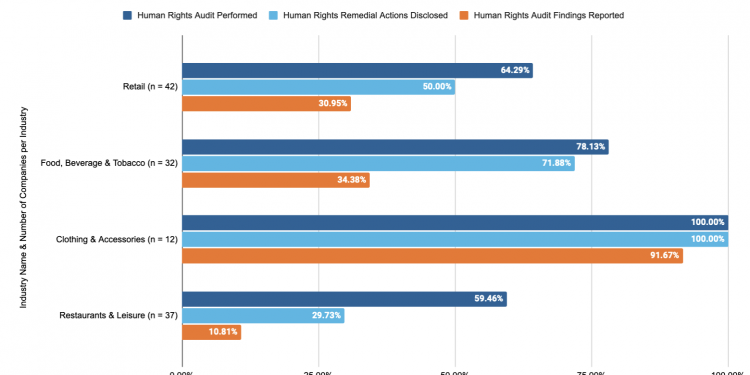This Tech CEO Works With Salesforce, Walmart, and Other Industry Leaders To Advance Pay Equity For Thousands of Workers

Amid the fiery debate around “woke capitalism” and pressure from 13 Republican Attorneys General to Fortune 500 companies following the Supreme Court’s decision on race-based college admissions, some experts worried that CEOs would back down from diversity, equity, and inclusion commitments around things like pay equity.
But in actuality, the opposite is true – at least that’s according to Maria Colacurcio, CEO of Syndio, a software tech company that helps Fortune 500 companies and others advance policies promoting pay equity and career equity, or policies that promote fair pay and fair promotion, respectively. Prior to joining Syndio, Colacurcio co-founded Smartsheet, a workplace management platform, and held leadership roles at Starbucks and Microsoft.
According to Colacurcio – who works with clients like Salesforce, Walmart, American Airlines, and General Mills – many C-suite leaders are pursuing pay equity and fair promotion policies more aggressively than before. In fact, some are “ignoring” the letters from Republican Attorney Generals altogether, she noted.
Business leaders aren’t backing down from the issue of pay equity because it continues to be an issue of interest for employees, which plays into the war for talent, and because of new state-level pay transparency laws, which are forcing companies to disclose salary ranges, she said. In addition, she noted, there’s mounting regulatory pressure – amid growing interest from the the Equal Employment Opportunity Commission (EEOC), whose chair recently declared pay equity a top focus, and the European Union, which passed a directive requiring pay transparency.
In a recent Q+A with JUST Capital, the Syndio CEO discussed the financial case for pay equity, what she learned from serving as a director at Starbucks during the company’s pay equity analysis, how to begin conducting an internal pay equity audit, artificial intelligence, and more.
Editor’s note: The following has been lightly edited for length and clarity.
There’s growing political debate around issues like pay equity. Have you seen a scaling back of CEOs on these issues?
We work with primarily Fortune 2000 companies, and we’re actually seeing quite the opposite. So in the wake of salary transparency laws, and a competitive talent market, which continues even amidst all the news of layoffs, we’re seeing a lot of companies doubling down on this work, including bellwethers across tech like Microsoft, Walmart in retail, Moderna in healthcare, and so on.
I think part of that is because folks realize there’s no going back to the old way. This generation of employees expects companies to pay equitably.

So what I’m hearing is that companies are not scaling back.
Absolutely. I think a lot of folks started immediately presuming that the Supreme Court’s recent ruling would cause a big rollback in diversity practices. And I think what it’s doing is more so bringing to light, what is the right way to measure this? What is the right way to think about analytics and measurement to ensure that we’re tracking in the right way toward our goals? I think that’s the really important part of this conversation that we need to continue to focus on.
Walk me through the bottom-line case for advancing pay equity.
This is about not only attracting the right type of talent, the type of talent that’s going to drive business performance, but also retaining that talent, because retaining your way to some kind of aspirational goal is much more efficient and cost effective than hiring your way to that goal. Gartner research found that 58% of workers would consider switching jobs for more transparency. For Gen Z employees, that number jumps to 70%.
Studies have shown that businesses with more diverse teams and leadership have better financial performance. According to McKinsey & Company, companies in the top quartile for gender diversity were 25% more likely to have above-average profitability than those in the bottom quartile. Additionally, companies with more racial and ethnic diversity were 36% more likely to have above-average profitability.
You served as a director at Starbucks, where you played a role in the company becoming one of the first Fortune 50 companies to go public with its pay equity results. What did you learn from that? I imagine that it’s scary for a company to do that for the first time.
It is scary. And kudos to Starbucks for being so progressive and being first to really take transparency and want to take it to that level, because no one was really doing that at the time. And, you know, they continue to be just an absolute powerhouse in what they’re doing.
That experience – in addition to co-founding Smartsheet [a software as a service offering for collaboration and work management] – was the impetus for Syndio, for figuring out how to solve these issues through technology.
Rob Porcarelli was the VP Assistant General Counsel at Starbucks – he now works as Syndio’s Chief Legal Officer. Through him, I learned how pay equity initiatives worked. They’re usually done through an outside consulting firm or law firm – it’s just very cumbersome, it’s archaic. It’s a long process. And more importantly, the recipient of the information doesn’t learn much, they just get a big stack of paper back, which tells them who to pay and how much, but they don’t learn anything about the root cause of the policies and behaviors that are driving those disparities. So we started talking. It was really this idea of like, how do we fix starting pay?

Why are you passionate about pay equity and career equity on a personal level?
So when I left Smartsheet, I had taken a couple years off to stay at home with my young kids, and I went through a divorce as I was transitioning back into the workforce. The motherhood penalty was a very real thing for me, even with the experience I’d had having worked at Microsoft and having been in tech for a long time. My experience with the motherhood penalty was very much a gut punch.
So I think that, combined with what Rob taught me in the process of going through that effort for Starbucks, is what opened my eyes to the fact that there’s so many different facets to this problem. It’s not just the fact that companies don’t have their fingertips on this data and analysis, it’s that they can’t do analysis quickly and efficiently. It’s about perception. How are folks perceived when they move into that role of motherhood? How does that show up in pay? How do we begin to combat that?
If I was a company contemplating taking on a pay equity or an opportunity analysis, can you walk me through some of the steps involved? Who should I talk to?
So I think the folks to get in the room are your HR team, your CHRO, your head of compensation or whoever’s handling that, and then I think the legal perspective is another really great perspective to have in the room, so your chief legal officer.
Now I’m the CEO of Syndio, so I’m gonna highly recommend our platform – we have clients who are best in class in their industries. I’m also going to recommend some free resources we have like our guide titled “The New Way to Fair Pay,” and our helpful communications playbook.
Then start the conversation: How can we make pay and opportunity equity a strategic business priority?
The best time to address pay equity is now. For every minute you wait, it actually compounds on itself and gets worse. There’s remediation that you’re going to have to pay if you’re living in a place where you have disparities because of gender, race, ethnicity – not to mention the potential brand catastrophic risk, if that comes out, in addition to lawyers, fees, settlement costs, other things like that, if you are entangled in some sort of litigation.
On the opportunity equity side, or ensuring all employees have the same shot at promotion, I think the real selling point here is that without precise metrics, a broad-based DEI effort can spend a lot of time and money trying to fix the wrong thing. There’s tech out there to help companies tackle DEI efficiently, in a really modern and specific way, using analytics to drive the measurement. It will show you where progress has been made and where there’s still opportunities for progress.
Artificial intelligence has generated a lot of interest in how it will impact the way people work. What impact do you see AI having on the work you do?
While AI isn’t new, the sophistication of AI is growing, and that will inevitably have an impact on how HR understands and interacts with information, including workplace equity. Natural language capabilities will empower companies to democratize insights and infuse fairness into decision-making at a larger scale. AI’s speed and efficiency can streamline data preparation for analysis, facilitating faster and more frequent assessments. With caution and understanding around the use of inputs, AI’s predictive capabilities can drive companies from reactive to proactive equity management.
However, these potent tools are built upon existing language and data and can therefore amplify biases ingrained in the status quo. To address this, we must focus on developing generative AI, large language models, and natural language processing tools that actively counteract biases in pay and opportunity-related decisions.
Members of JUST Capital’s Corporate Impact Initiatives engage with Syndio, among other impact partners, to help them navigate workforce investments and deliver on their equity commitments.






